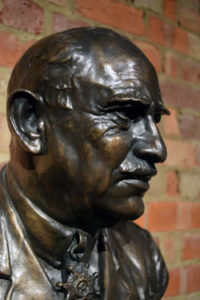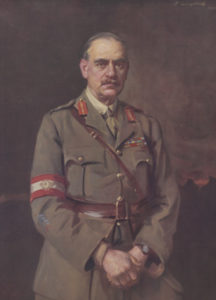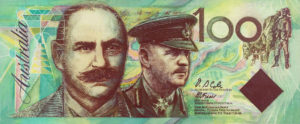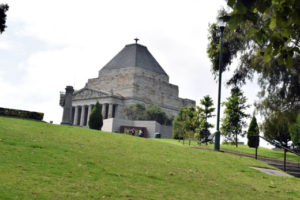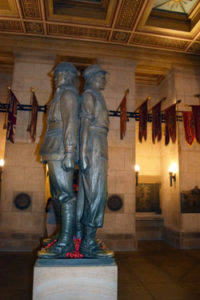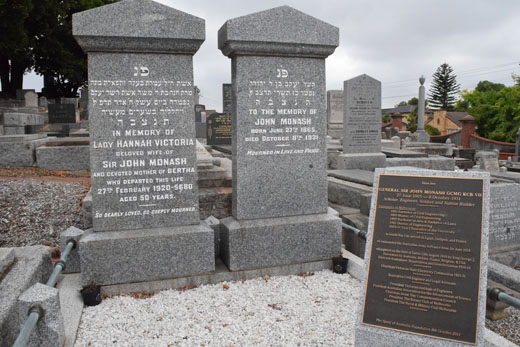Sir John & Lady Monash of Melbourne, Australia
Values Codes I – H – E – L – P
John Monash was born in 1865 to Louis and Bertha Monash, who had come to Australia from the area of Posen, Poland/Russia.
While growing up, John sang in the choir of East Melbourne Synagogue, where he was also a bar mitzvah.
He attended the University of Melbourne receiving his degree of Civil Engineering in 1891, his masters in Civil Engineering in 1893, and his doctorate of Engineering in 1923.
In 1931, John Monash became Chancellorof the University.
Military
In World War I, John Monash served in Egypt, Gallipoli, and France.
By the time World War I erupted in 1914, Monash was a colonel commanding Australia’s 13th Infantry Brigade, which departed for Egypt in a convoy of 17 ships.
In 1915, his brigade, which had been held in reserve, participated in the disastrous Gallipoli Campaign in Turkey, during which British forces sought unsuccessfully to dislodge Turkish forces from the narrow sea channel connecting the Aegean Sea to the Black Sea via the Dardanelles and the Bosporus.
Although the Gallipoli campaign was a military failure for the Australians and New Zealanders who fought alongside the British, an annual ceremony to remember the sacrifice and the courage of the soldiers who fought in that campaign evolved into ANZAC Day, an acronym for a day of tribute to the Australia New Zealand Army Corps.
When Monash arrived in France, he learned he had been promoted to Brigadier General, a promotion that was followed in quick order to Major General, and then to Lieutenant General.
He commanded the Australian Army in France in 1918 & 1919.
In the Battle of Hamel (France), General Monash departed from what some considered the usual British practice of using colonial troops as cannon fodder. He planned a surprise attack on July 4, 1918, on the German-held French town, in which tanks, artillery, airplanes, and infantry were thrown into the battle in a meticulous and coordinated attack that historians have attributed to Monash’s engineering background.
Instead of having the infantry up front and exposed to enemy fire, Monash had them advance behind the tanks.
While Monash had predicted the Battle of Hamel would be won in 90 minutes, he was wrong — it took 93 minutes!
Hamel was a dress rehearsal for the larger Battle of Amiens, which Monash, then “Sir John,” thanks to King George V, was instrumental in planning.
The Australian Corps under Lieutenant General John Monash held the right flank and linked up with French armies to the south.
The Germans retreated in the face of the large-scale coordinated attack.
Only three months and three days later, the Germans would sign the Armistice Agreement ending the war.
Following the cessation of hostilities, Monash was put in charge of demobilizing and repatriating some 160,000 Australian soldiers — itself an engineering feat which he accomplished with characteristic attention to detail.
Post War Australia
John Monash served as the Chairman of the Victorian State Electricity Commission from 1921 to 1931.
He was President of the Victorian Institute of Engineers, President of the Australian Association for the Advancement of Science, Chairman of the Anzac Day Commemoration Council, President of the Rotary Club of Melbourne and President of the Navel & Military Club of Melbourne.
In 1927, he became the National President of the Australian Zionist Federation.
Legacies
This Jewish General is remembered by his fellow Australians in Melbourne with the following institutions and places that bear his name: Monash University, the suburb of Monash, Monash Medical Center, Monash Freeway, John Monash Science School, and Sir Monash Drive.
His face is also on Australia’s $100.00 Bill and their $5 Coin.
Lady Hannah Victoria Moss Monash died in 1920.
John Monash died in 1931. His funeral procession reportedly was witnessed by a quarter million people.
Sources
- The Australian Dictionary of Biography, http://adb.anu.edu.au/
- G. Serle, John Monash: A Biography (Melbourne, 1982)
- P. Pedersen, Monash as Military Commander (Melbourne, 1985).
Donald H. Harrison is the curator for this Sir John & Lady Monash exhibition.
Most photo’s are by Harrison from his recent trip to Australia. See his Jewish historical site for the San Diego Area at SDJewishworld.com
